
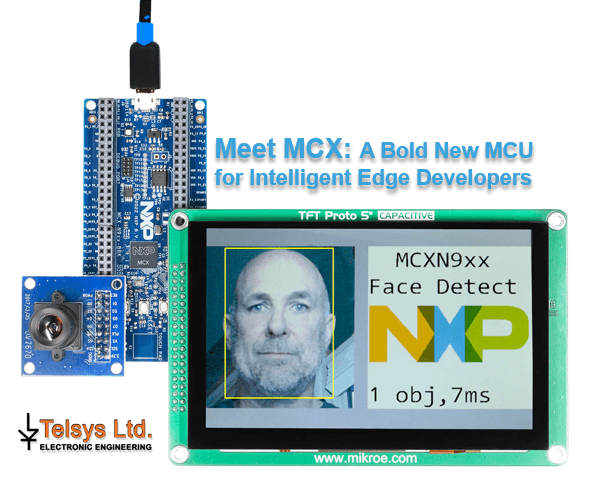

Meet MCX: A Bold New MCU Experience for Intelligent Edge Developers
In the 50 years since the rise of the first microcontrollers (MCUs), we’ve seen continuous advancements in MCU technologies as these highly integrated devices have become more powerful, energy-efficient, rich in peripherals, secure and intelligent. While general-purpose 32-bit devices dominate today’s broad MCU market, most portfolios include diversified offerings optimized for specific applications, ranging from industrial control to IoT connectivity to precision analog and much more.
Modern applications expect more from their MCU platforms than ever before. Creating intelligent edge devices requires them to address complex security challenges, IoT connectivity requirements and power limitations, while delivering advanced machine learning (ML) capabilities to process vision and voice inputs and predict human intentions with greater accuracy.

Some applications require dedicated neural processing acceleration to tackle ML workloads. Others need low-power wireless connectivity for IoT devices that stretch battery life from months to years. Still, others need precision analog for motor control and industrial automation. Everyone requires the latest security technologies to stay a step ahead of cyber adversaries or to prevent cloning by competitors. Scalable levels of performance, memory and functionality across broad portfolios are also a must. And every MCU platform must be backed by a rich ecosystem of software and tools that streamline development.
NXP debuts new MCX portfolio of MCUs
for the next era of advanced industrial and IoT edge computing. Read more about the new MCU of choice.
MCX: Merging the Best of Two Leading MCU Platforms
Born from the cross-platform convergence of NXP’s industry-leading LPC and Kinetis MCU families, the MCX portfolio combines the DNA of each family to redefine the future of general-purpose MCUs for the intelligent, connected edge and industrial applications. Using NXP’s decades of MCU expertise as a guide, we’ve brought together the best features, peripherals and capabilities of LPC and Kinetis and created an all-new, purpose-built portfolio. Backed by the popular and widely used MCUXpresso suite of software and development tools, MCX gives developers a bold, new future for scalable, smart and secure system design. The MCX portfolio offers optimal enablement, dedicated accelerators, analog integration and a host of peripherals and memory options for any power- and cost-sensitive application that needs intelligence, voice, precision motor control and wireless connectivity.

For existing LPC and Kinetis customers, the MCX family offers more memory options and lower power requirements and it preserves their engineering investment by enabling them to port existing code to a next-generation MCU platform with no need to redesign from the ground up. New customers benefit from the portfolio’s scalability, simplified system design and developer-focused software. When evolving designs call for more performance and capabilities, MCX customers can leverage NXP’s broad portfolios of i.MX RT crossover MCUs and i.MX applications processors for future growth.
Four MCX Series with Shared DNA
Powered by a high-performance Arm® Cortex®-M33 core, the general-purpose MCX MCUs are built on a common foundation of low-power processing, advanced on-chip security and wireless connectivity technologies. The portfolio also features the first occurrence of NXP’s new, specialized neural processing unit (NPU) for accelerating inference at the edge, delivering up to 30x faster machine learning throughput compared to a CPU core alone. Scalable memory options include up to 4 MB of flash memory supported by a low-power cache, advanced memory management controllers and up to 1MB of SRAM to enhance real-time performance.
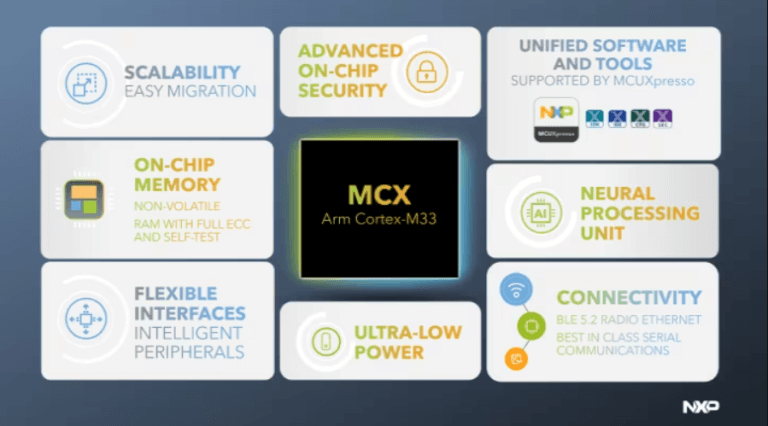
The MCX portfolio debuts four new MCU series offering the right mix of scalability, optimized integration and developer-focused software to simplify system design.
- The MCX N Advanced series is designed for secure, intelligent applications, with families that include an integrated EdgeLock secure subsystem and dedicated NPU with a high-efficiency compute architecture for real-time inference.
- The MCX A Essential series is optimized to provide critical functionality for a broad range of applications such as motor control, where cost constraints, advanced analog capabilities such as high-precision data converters and fast time to market are key considerations.
- The MCX W Wireless series offers low-power narrowband connectivity, including Bluetooth® Low Energy. Designed to simplify adding wireless connectivity to IoT devices, its energy-efficient radio helps extend the battery life of small connected systems.
- The MCX L Ultra-Low Power series is designed for power-critical applications. With one of the industry’s lowest static and dynamic power consumption, these devices will help extend battery life significantly compared to traditional MCUs.
The MCX MCUs are available in popular package options, ranging from TSSOP to BGA and from 16 to 200 pins, to fit your system design needs.
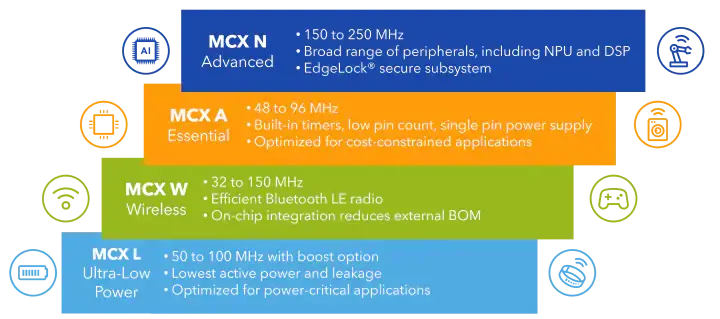
A Unified Development Ecosystem
Each MCX MCU series is supported by the unified MCUXpresso suite of software and tools. The widely used, developer-focused MCUXpresso ecosystem provides comprehensive, easy-to-use development tools and enables software technologies designed to optimize, simplify and accelerate system development, allowing customers to focus on differentiating their designs. The MCUXpresso SDK includes key application examples such as asset trackers, beacons, wireless sensors and other devices to help developers get up and running quickly. Using MCUXpresso, existing customers can reuse and port their code easily and preserve their engineering investment.
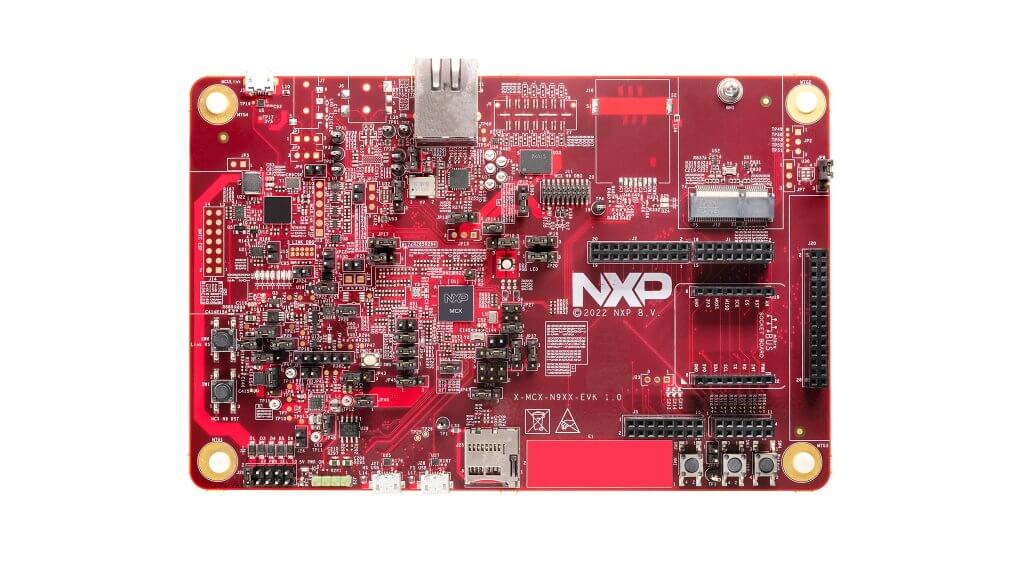
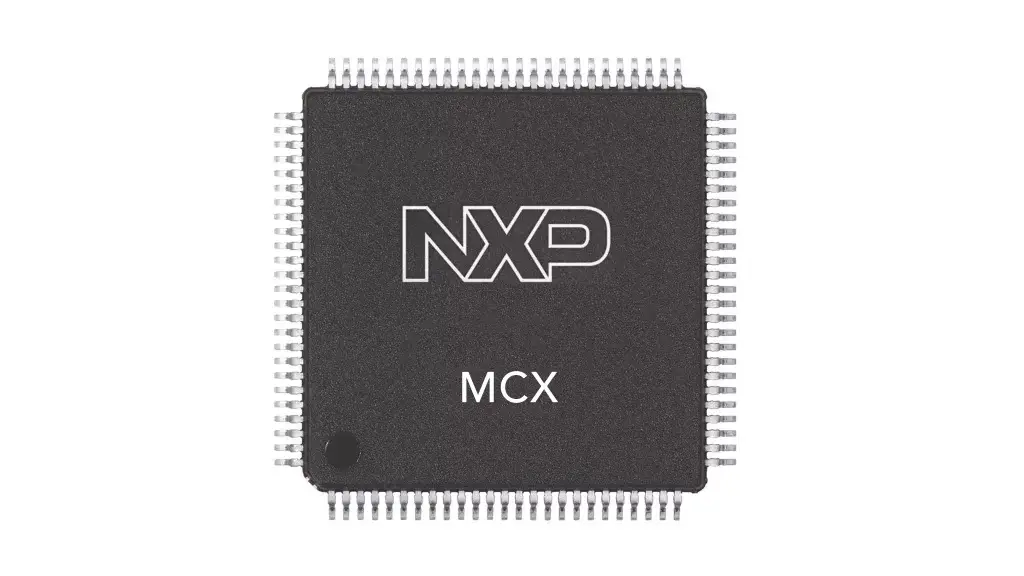
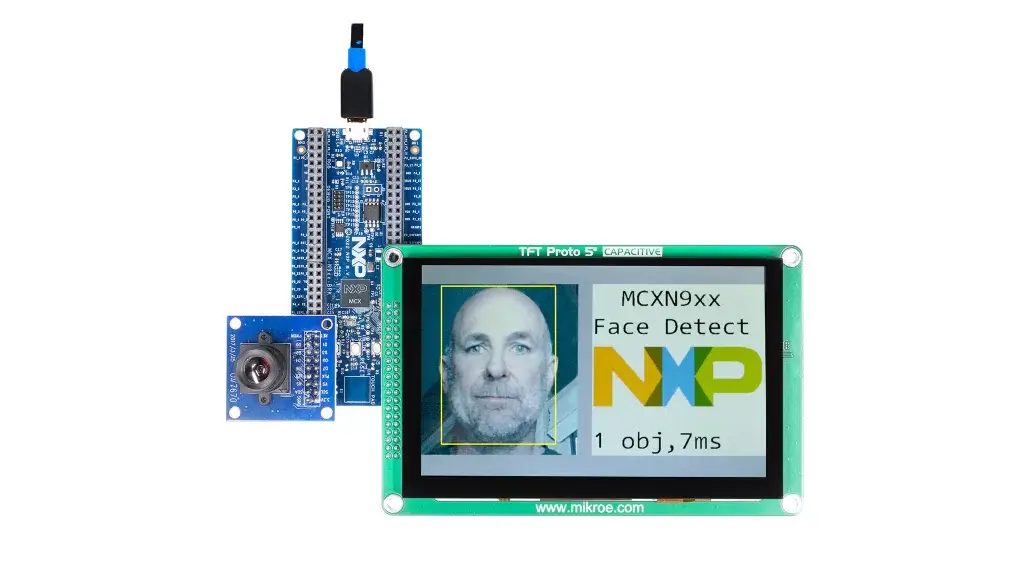
Looking to the future of MCUs for edge intelligence
Delivering multitasking performance and advanced neural networking and ML capabilities with a low-power 150 MHz MCU may seem extraordinarily difficult, but the MCX N94x and MCX N54x devices are not ordinary MCUs. They are marvels of multicore design and peripheral integration.
The MCX N94x and MCX N54x are based on dual high-performance Arm® Cortex®-M33 cores running up to 150 MHz, along with 2MB of flash with optional full ECC RAM, smart DMA, a DSP co-processor, a secure subsystem and an integrated NXP-designed NPU. Developers can use any combination of these cores and accelerators for specific tasks without driving up the MCU clock speed or increasing power consumption.
The dual-core architecture pairs a full-featured Cortex-M33 core with a streamlined M33 core to manage control functions, enabling developers to run applications in parallel or reduce overall power consumption by turning off individual cores as needed. For example, during secure over-the-air (OTA) updates for IoT devices, the main M33 core can handle system security, while the second streamlined core executes control functionality.
The MCX N MCUs include NXP’s first instantiation of its specialized NPU designed to enable high-performance, low-power intelligence at the edge. The on-chip NPU delivers up to 30x faster ML throughput compared to using a CPU core alone.
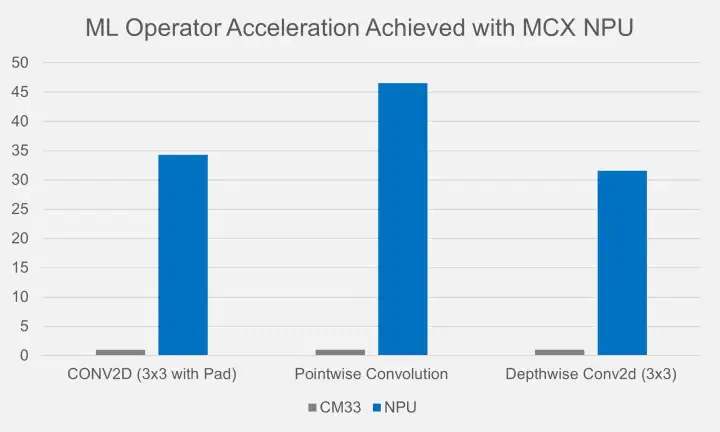
This top of MCU class ML performance expands TinyML capabilities for resource- and power-constrained edge devices. Imagine the possibilities: you can implement sophisticated deep-learning models, add face and voice recognition for access control, create battery-powered glass-break detectors for home security systems, develop vibration sensors for motor control predictive maintenance and design smart wearable devices equipped with bio sensors.
Flexible and Secure by Design
The MCX N Series peripheral flexibility is like a developer’s treasure box. The high-resolution mixed-signal analog peripherals are designed to operate with greater autonomy to minimize CPU interrupts and save power. For example, the ADCs have built-in intelligence to continually collect data and average the stored data locally. Each of the MCUs’ two 16-bit ADCs can be used as two single-end input ADCs (effectively functioning as four ADCs) or as a single differential input ADC.
Industrial-strength communications peripherals include Ethernet, CAN-FD, BLDC/PMSM motor control support, high-speed and full-speed USB, and integrated sensor interfaces (MIPI-I3C, I2C, UART and SPI). For added flexibility, NXP’s LP Flexcomm interface allows any combination of ten serial peripherals including SPI, UART and I2C.
Built following NXP’s secure-by-design approach, the MCX N series MCUs feature an EdgeLock® secure subsystem having a secure boot with an immutable root-of-trust, hardware-accelerated cryptography, active and passive intrusion detection plus voltage and temperature tamper detection. This best-in-class security architecture provides support for in-field updates, online transactions and protection against over-production at remote original design manufacturers (ODMs).
Helpful Resources
Web
Contact Us for more details or request
